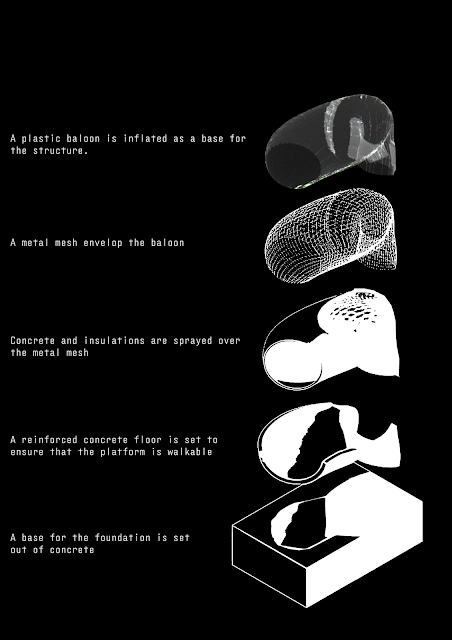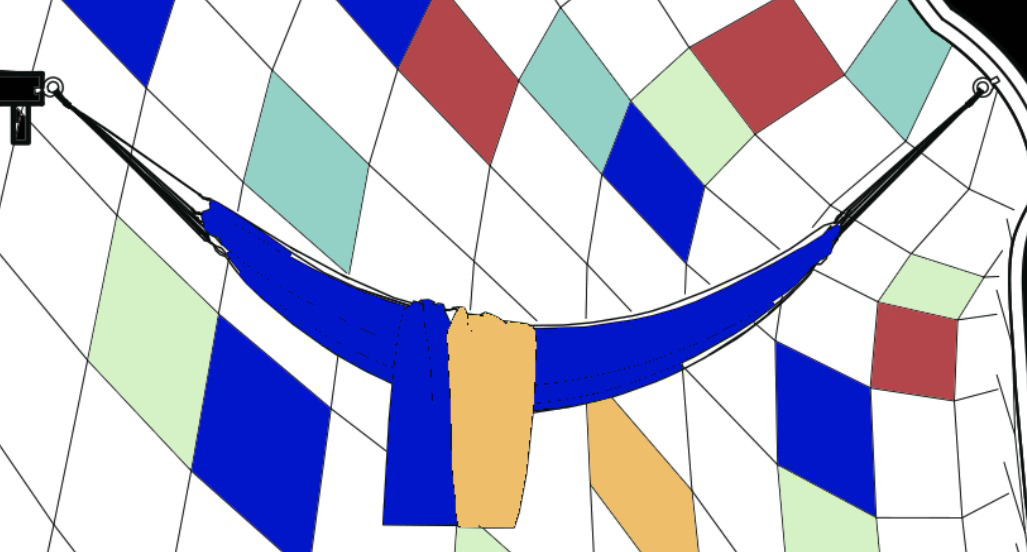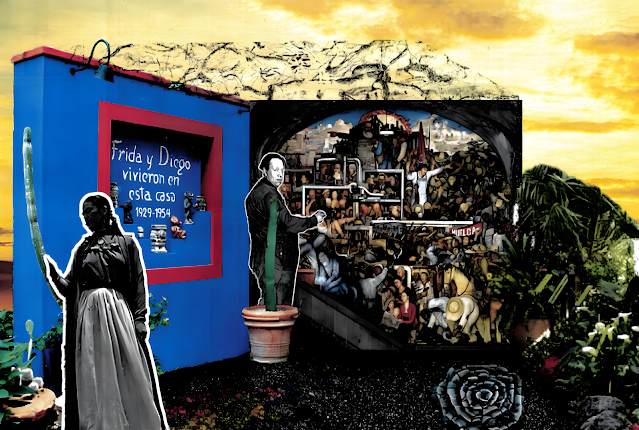
One of the many components of life; time and space. They exist together. They flow into each other. One is incomplete without the other and we as humans are bound to them. We do not sense this synergy in our daily life. Daily life is now far away from the drama, no need for being under the sun for hours or taking long runs that last a day. The drama of Karapınar lays under this equiliubrum. To be able experience the sinkholes you have to climb down 50 meters of steep rocks or have to walk across unstable ground with all texture which you never do in the city now. This equilibrium makes us wonder how the spaces can be created in such an environment. The environment that feels different in every plot, has different conditions in terms of suns location, weather, noise and most importantly time. Karapınar is dramaic because every point in the sinkholes has its' potential to set out on a journey. This is why we start our journey from here, Plots or the moments in the real world are now our points and the fluxes and memories are our lines.
ACT I
The First act is about trying to understand the variations of fluxes according to the points locations, how close is one to each other or is there any obstacle for points to connect and accordingly how the textures are shaped but not selected to create the final result, understanding the compenents of the overall texture.
Rondom points on the canvas are connected with the lines to go the main lines with the shorest path possible. Different formations shape distinct figures. This creates a way of creating textures out of basic rules. This is the first act to understand our journey and how the seeds are sown. For the details of these textures markings tag can be investigated."
ACT II
Second act is about transmitting the ideas to the digital world. We have one anchor point and
3 neccesary points (by saying) on the world. They are connected to the anchor point by the shortest path. This experiment is done by using Geometry Nodes of Blender.
In each scenerio program chooses to go from a different path. Three necessary points are connected to the anchor point but in the first image two of them close to each other so program chooses to connect them before the third poin that is on the left hand side. But when we look at the third image program chooses the three necessary points to connect in one flux and transmit them accordingly.
Still the progress goes in and two dimensional domain. And the point cloud is not three dimensional yet.
ACT III
The third act is the first test to integrate the two dimensional canvas to the three dimensional world. A set of necessary lines on the world in different positions and they are all connected to 4 anchor points. This time the points are intentionally not signed, as there are enough of necessary points, the anchor point is now one of them.
Every necessary point connects itself to the anchor points in an unvariable way and when the path is set, the new added points follow the path that is already existing. They grow cumulatively in one way. In other words, the fluxes are set in a non-destructive manner. Which means that they do not reconstruct themselves when a new necessary point is added, even when it is more suitable if it does so.
ACT IV
The fourth act now comprises the 3rd dimensional domain which necessary points are selected and connected by the domain's rules. The main lines are also follows the paths of the points connection and are affected by how each point close one to another. The domain is the main decider of how the texture will be applied. The example shows how fluxes turned into spaces.
First two anchor points and inner necessary points are set out of the domain of points. Then the necessary points are bound to each other in fluxes and when the flux is seen suitable for the model necessary parts are inflated, which turns necessary points into 3 dimensional plots therefore our reality. Points become spaces that as humans we can experience.
Until now the process of creating our texture is turned into a 3 dimensional space, the world of points and lines has no colors, but our world has. Let's see the project without colors one more time to see how the ideas are applied to the final project.
So far how the ideas of textures are ejected to the project is seen but where exactly this project is taking place is still an important question.
The idea of building the textural spaces.

The sudio is called "Palaces Somewhere" and we started to have an idea of whatness of "somewhere" but how about the palace? The last studio of the professor was about luxury and palaces are a different part of As I thought this cannot be explained from pieces but as a whole, I will have to ask you to endure the long discussions without a break. This is the manifest of progressive palaces.
Palaces as the results of our society
Palaces are phenomenons that we as a society create. Every detail about a palace says something about its societies dynamics. Which resources the society has and how they are transformed, who can use those resources or if the income distrubition is balanced, all of this questions can be answered by investigating the palace or palaces of that society. Even when there is a contrast between the palace’s glory and societies poverty, it tells something about the societies pre-acceptance of their dynamics.
First of all, metarial or sociological wise; we can say that palaces are the indicators of their society. How a state acts and how people reacts to it, can be understood directly from the palace. This makes palaces to be considered as a phenonenon of today but not tomorrow. Because eventhough the phsyical aspects of the palace can be the same the sociological aspects change over time. This makes a palace to be used in different way, The room that one day was hosting the crowns the other day can witness the crown to be burnt. So we can say that the palaces affect today but not directly the future.
The second point that when the palaces exist they are actually the result of the societies constant decisions. The palace does not make itself exist in one day and the reason is not the construction time. For a palace to exist everyone should believe that it is necessary to construct that palace for them to have a better life. A palace that they will never see or get into should exist because someone has to decide for them or someone has to ensure the justice between them. This pre-acceptances turns the palaces to turn into realities. Maybe a palace can be seen as a price of having a peaceful life. With all its reasons, for a palace to exist everyone should be willing to put one brick on the palace if necessary. This makes the palaces connected to the past as well as today. But the
deadlock is it can’t be associated with the future in its current form since it is a cold and unwieldy reality that has no capacity to fit into the wheels of the world.
Palaces are not the only realities that society create. Society creates the indivual and the individuals form the society together. Some of those individuals reshape the society with their thoughts, acts or lifestlye. They can be a figure of independance, they can be a figure of power or they can simply be a figure that changes the humor of the society. The conditions of the current society creates people that will change the same conditions if necessary. This force can be seen as the same force that creates the palaces. But the important point is that the force of the society with its dynamics always looks towards the future. The past of the society affects the current positions to change which shapes the future.
So the idea is that, against the unweildy palaces, can this force of society with its important figures, correspond the definitions of palace withh looking toward the future. The figures that is mentioned are not out of this world. When they do something different than the norms, they are called different because there is a reality to differenciate. Our figure only sees and acts on it. Being affected, acting on it and affecting the others is the most humane thing we can ever see.
So creating spaces that carries the ideas of our figures is a result of society itself even when it does not validate every action as it is in the palaces. But the main difference is it re-circulate itself when it is time to press the wheels as it is estabilished on the thoughts and the thought are the force itself to create the change.
So an idea of creating a commune that creates their spaces as they live. Experience and affect each other as they live apply their ideas as they live through together. It is good to note that we have to ignore the chemistry between the figures and only focus on their ideas of spaces, here we will seee some of the spaces that is applied with the ideas of our commune members.

Friedensreich Hundertwasser, an Austrian painter and architect, stands out as an interesting subject of study due to his concept of creating distinctive buildings for each person. He believes that everyone has the ability to paint and create art, employing straightforward techniques to demonstrate this to the public. This approach results in his buildings and paintings having a playful, almost childlike works
In contrast, Franz Kafka, a German-speaking Bohemian writer born in 1883, consistently struggles with societal conflicts in his works, prompting us to reflect on our own place within the world. Kafka is renowned for his complex narratives and themes of alienation, existential anxiety, and the absurdity of human existence.
Hundertwasser's celebration of individuality through vibrant and whimsical designs starkly contrasts with Kafka's exploration of conflict and introspection, offering a fascinating comparison between two distinctive approaches to understanding and expressing the human experience.
Section AA' demonstrate the colorful textures and constant mirrors that makes us question ourselves a gramaphone is located at the top to circulate the words of Kafka about the society. Some words are even gibberish, it affects the indivdiual the most at night...
Section BB' demonstrate Alice Waters's cooking area, she is a cook that is known with her approach to the food. She started the movement of slow food against fast food, she believes that everyone should eat local and organic food, she applie this rules in her restaurant. On the contrast Karapınar is known the only desert of Turkey. How she will develop her ideas on that contrast is an interesting topic to investigate as the only water resource is below the ground. She grows her own food but she has to use the water if she will live here.
On the section the stone oven of Alice Waters can be seen. We see the water boiler and the plants she grows at the bottom the blue door goes to the coop.
Section CC' shows the rooms of the figures. From bottom to the top Kafka, Allice waters and Hundertwasser's rooms can be seen. Kafka's room doesn't have much of a light. and even when there is enough light his chair against it.
On the other hand Friederich has a colorful room that has no flat ground but all the surfaces are steep, he has a rope to climb and a hammock to sleep.
On the other hand Alice Waters has a special kitchen in the room and has a garden that she can grow her plants
(The room of Kafka)
(The kitchen of Alice Waters).
(Hamamock of Hundertwasser)
Frida kahlo is an important figure for the feminist movement and she is known with her auto-portraits and her suffers, they have an interesting life with her lover Diego Rivera. Kahlo had ideas of a garden and grown plants in her healthy days. Rethinking those gardens in Karapınar can be a way to understand her more and a way of reinventing the norms of architecture by thinking them from a figures perspective.
(Axonometricc view of the flux)













.png)





